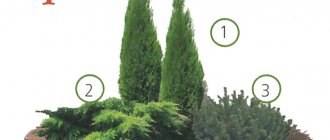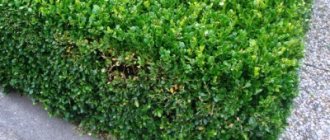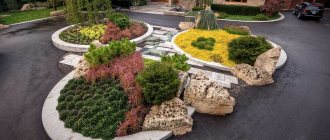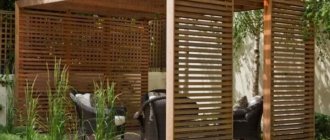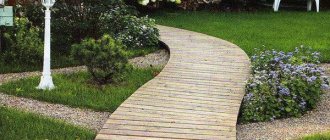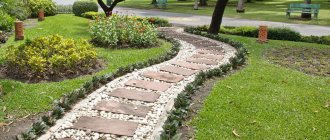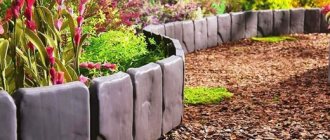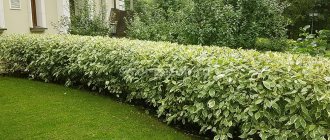The budget for building a fence on a plot of land is not always large enough, and sometimes there is none at all. There are several options for the cheapest fences, but the best way out of the situation is to create a hedge. Many shrubs and trees reproduce independently and grow almost anywhere, with free access, for example, in forests and parks. In this case, you can plant a neat green fence without purchasing plants.
Types of living fences
There is no need to invest a large amount of money in the construction of a hedge on a summer cottage instead of a solid fence. At the same time, the dacha will look wonderful, natural ventilation will remain in the area, and during flowering there will be a delightful aroma in the air. According to the method of growth, fences can be curly, clipped, or free-growing. One of the excellent options for designing a site is considered to be a free-growing planting. It doesn't need to be trimmed. But everyone needs to be looked after. According to the types of plantings, the fences are flowering, deciduous, and coniferous.
Installing a ventilated fence is not difficult, but today some dacha owners prefer to cover the enclosing structure with a decorative camouflage mesh designed for dacha fences. It is made of soft and beautiful material that replicates a green fence made of weaving plantings. The most important advantage is that the grid remains the same throughout the year. Camouflage mesh models are constantly being improved. Today, products with a 3D effect are considered the most original. The model has curved rods, which make the fence voluminous and textured. But there is nothing better than making hedges for your dacha yourself. Multi-level options look great. One row can be created from boxwood with red leaves, the next from green juniper, the third from dark gray spruce.
shorn
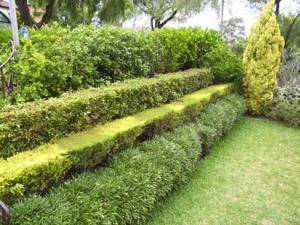
Living fences of this type need to be properly cared for, constantly trimmed, and created interesting shapes. All varieties of thuja tolerate systematic pruning quite well. You can create an original fence by planting shrubs with small foliage, this could be wolfberry (privet), cotoneaster, or euonymus. In the first years, they will form a uniform, dense crown, and as soon as the branches grow, after about 14 days, they need to be cut.
Free growing

Plants for this type of hedge grow freely. They do not need to be constantly looked after and shaped. They require a lot of space as they are directed in different directions. For a free-growing hedge, it is recommended to plant:
- Niedzwiecki apple tree;
- barberry;
- hawthorn;
- honeysuckle;
- rhododendron.
A garden hedge made of rosehip will become a real decoration, pleasing the eye with pretty flowers and bright berries. Basically, these plants lose their leaves in winter, so their appearance at this time of year becomes unattractive.
Loaches

You can use climbing plants for a hedge in your dacha, but they need support. An excellent option is creeping vines. Their roots, like suction cups, crawl to any height and can cover a 3-4 meter fence. Climbing roses, clematis, hops, virgin grapes, and ivy are well suited for climbing country fencing. A fast-growing hedge in the garden can be created with the help of ivy that grows in a short period of time. The plant is very resilient and unpretentious. From spring to late autumn, the color and appearance of the structure will be different.
Plastic mesh for creating hedges

Plastic is a fairly strong material that can easily withstand changes in weather conditions and high humidity. If you want to fence your summer cottage in an original way and at an affordable price, then you can use a special plastic mesh for climbing plants for this purpose. The advantages of such a fence are obvious.
- Light weight.
- Resistance to corrosion.
- Easy to install and install.
- Affordable price.
- Variability of sizes and colors of plastic sheeting.
- Good light and water permeability.
- Heat resistance.
- Strength and durability.
Installation of plastic mesh to support hedges
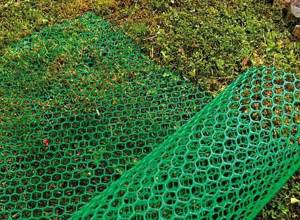
Tools and materials
- Plastic mesh. The dimensions depend on the area of the fenced area.
- Poles for fixing the mesh; you can use wooden or metal supports.
- Crushed stone.
- Cement.
- Clamps for fixing the mesh to the posts.
- Metal wire.
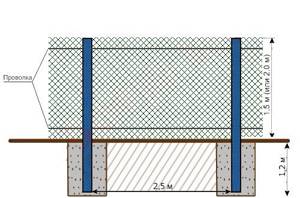
Tension fencing device
Step 1. Since the plastic fencing sheet itself is light in weight, it is not necessary to deepen the posts too much. It is advisable to place the supports at a distance of 1.5-2 meters from each other. To install the pillars, you need to dig holes 40-50 cm deep. After installing the pillars, you need to fill the recesses with crushed stone and pour cement mortar. Such designs take 2-3 days to dry.

Tension fence
Step 2. After the pillars are firmly fixed in the ground, you can begin installing the plastic sheet. The canvas does not need to be cut into pieces. If metal pipes were used for the supports, then special hooks can be welded onto them, to which the mesh will be attached. If welding work cannot be carried out, then ordinary plastic clamps can be used.
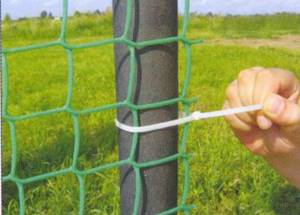
Mesh attachment
Step 3. When installing the mesh, it is important to maintain uniform tension of the material. The canvas must not sag. If the distance between the supports is more than 1.5 meters, then it is advisable to use wire that will serve as upper and lower stiffeners. The wire is stretched along the upper and lower edges of the mesh and attached to the posts.
Step 4. The connection of the mesh panels should pass along the supports. You cannot extend the canvas between the pillars.
Step 5. Once the mesh fencing is installed, you can begin landscaping the structure. Plastic is a durable material; it can easily support the weight of grapes, ivy, honeysuckle, and campsis. These perennial plants will become a real decoration of your garden plot and will reliably protect the area from prying eyes.

All that remains is to plant plants along such a fence and soon a beautiful hedge will appear
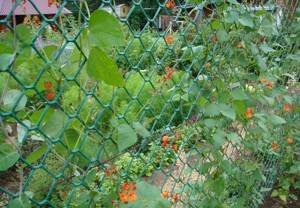
Plants hold on to the net
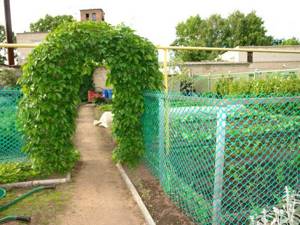
A living arch would be appropriate next to a hedge
Video - Installation of plastic mesh
Prices for different types of plastic fence mesh
Plastic mesh
Classification of hedges by height

Living fences are made of different heights and thicknesses. They can be:
- low – up to 50 cm;
- medium - from 60 cm to 1.5 m;
- high - over 1.5 m.
Attention!
Experts recommend, if space allows, to opt for a multi-row option of different levels.
A planting of one type of plant with leaves of different colors, or a combination of different varieties, looks great. However, it is necessary to take into account their survival rate on the ground, the speed at which they grow, their flowering time, frost resistance, and their requirements for care.
Zoning
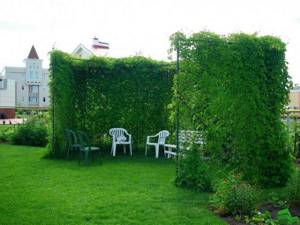
Plants can be used to zone areas into functional areas. Thanks to this planning, the environment will become comfortable and attractive. A dense wall of trees will help protect the playing area from the sun's rays. For the children's area, you should not choose thorny plants or those whose fruits are inedible. For a recreation area you can plant bushes:
- sea buckthorn;
- elderberries;
- hawthorn;
- barberry;
- rosehip;
- lilac;
- viburnum of a certain variety.
In addition to beauty, the blackcurrant hedge pleases with its fruits. A suitable flower is the tea rose, which blooms for a long time, exuding a magnificent aroma. In order for the green fence to be reliably protected as a fence in landscape design, it is recommended to strengthen it with a second tier.
Living wall
A living wall means green fences, the height of which is more than 2 m. Trees that tolerate pruning are used for them:
- juniper;
- spruce;
- common hornbeam;
- thuja;
- white globular willow;
- Linden.
Most often, trees are planted on the street side along the border of the territory. Ornamental shrubs can be planted in front. They will cover the bottom and all gaps. Flowering border plants are often planted at the foot. Thanks to the high wall, the land and plantings on the site will be protected from strong winds and erosion.
Attention!
It must be borne in mind that it will take a long time before the hedge becomes tall.
Borders for lawns and flower beds

Borders are considered to be fences smaller than 1 m. On a site, they frame flower beds, mark zones, or are simply used for decoration. The path in the country can also be framed with curbs. Certain types of flowering and herbaceous plants and shrubs are well suited for beauty. You can plant:
- hawthorn;
- cotoneaster;
- barberry;
- dwarf jasmine species;
- low-growing boxwood;
- western thuja;
- columnar juniper.
It is better to give some shrubs a rectangular shape, for example, hawthorn and barberry.
What to plant

Most trees and shrubs can become a living fence, depending on how you plant them.
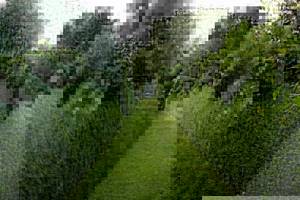
You can buy small sprouts and wait until they grow (an inexpensive option), or you can immediately take ready-made bushes grown for sale and plant them in your garden (this option will cost more). Evergreen sprouts are often sold as roots in the ground, wrapped in a synthetic or natural fiber wrapper. Some wrappers are made so that you can plant the plant in the ground with them, other packaging should be removed and the plant itself planted, so ask the seller about the features.
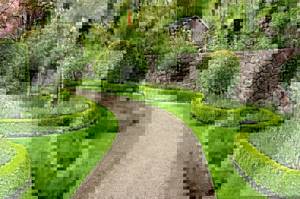
Small hedges are about 60cm high, can be bought inexpensively and are easy to plant. The taller the plants, the more expensive they are and the more attention they need.
Review of the most suitable plants: names and photos
In order for your site to look great all year round, you need to listen to the recommendations of experts. Much depends on what plants are chosen for a hedge made with your own hands at the dacha. It is important to plant green spaces correctly. Any fence needs to be carefully looked after; only a well-groomed appearance will make the area attractive. To make the right choice and plant the plants correctly, you should consider all options and design ideas. Even a general idea will help you choose the most suitable plants for your summer cottage.
Holly
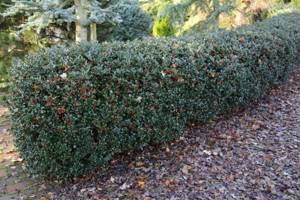
This shrub has dark green leaves with a shiny surface. It is precisely because they are prickly that the fence turns out to be impassable and several meters high. Holly is unpretentious and grows normally in partial shade and sun. Holly bushes for hedges form it within 4-5 years. But this is only if plants that are in a good stage of development are planted in the ground. Bushes must be planted at a distance of 60 cm from each other. This is done in April or October-November. It is recommended to prune at the end of July.
Periwinkle
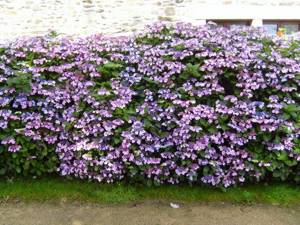
This is a herbaceous plant with erect shoots, but there are also subshrubs creeping along the ground. The inflorescences are blue, white, purple, pink. They can be planted on cloudy days in summer, late autumn and spring. Periwinkle grows in shady and sunny places. The plant does not need additional watering. After flowering has finished, the periwinkle must be trimmed. This contributes to its renewal and further formation.
Euonymus Fortune
A low and wide border can be created using euonymus. This very low shrub grows slowly and almost creeps along the ground. Its long 3 m shoots cover the entire surface around them. The stems have many leathery leaves that grow 3-5 cm in length. The foliage of Fortune's euonymus is white-green and has pink veins. The shrub is drought resistant. It takes well to pruning and grows well in semi-shaded areas.
Privet

Very often, privet is planted from shrubs for fencing at the dacha. The plant grows quickly and takes root well in shaded areas. However, if the acidity of the soil is increased or the soil in the area is very dry and sandy, the shrub will not grow well. Some experts advise replanting privet in the fall, while others believe that the best time is spring before the buds open. Watering should be done rarely, but abundantly. If the summer is not dry, then it has enough natural precipitation. Privet can be given curly haircuts. New shoots grow quickly.
Spruce
Evergreen coniferous fencing is popular. Coniferous plantings have a positive effect on the surrounding air, purify it, and neutralize unpleasant odors. They reliably protect the area from dust in summer and from snow in winter. Such trees are resistant to various diseases. They grow slowly, so they rarely need to be formed. It should be noted that all coniferous trees love a humid environment. In dry soil they stop growing.
Rhododendron
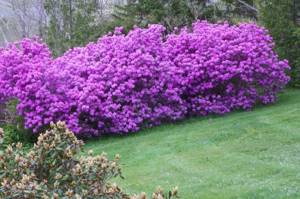
For various borders and paths, low-growing varieties with a compact crown are chosen. Shrubs are distinguished by their variety of shapes and colors, among them there are those that have excellent decorative qualities. However, they all need appropriate conditions; they need sun or, in extreme cases, partial shade. And evergreen varieties should be protected from bright sunlight, otherwise the plant will get burned. Rhododendron must be protected from cold winds. To grow properly, they must grow in well-drained and acidic soil.
Brilliant cotoneaster
The fencing at the dacha made of shiny cotoneaster looks very beautiful. The bush is formed by erect stems that are tightly located to each other. It has a very fluffy and dense crown. The shrub can grow to a height of no more than 2 m. Sold as seedlings. Requires constant care, which consists of watering, loosening, and mandatory haircuts. Once the cotoneaster is well established, it will be possible to water only during severe drought. At any time of the year it is allowed to trim old and unnecessary branches. Sanitary pruning allows you to rejuvenate and shape the bush. The work is carried out in the spring before the first buds appear.
Barberry
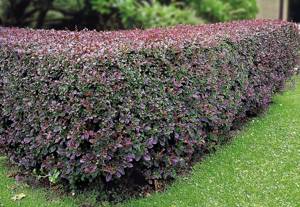
A green fence can be made by planting barberries along the fence in the spring. After a year, it needs to be pruned, cutting out dry and weak shoots. The plant is unpretentious, it is not afraid of wind and draft. However, you should not plant in soil that is highly acidic. On normal days there is no need to water additionally, but when there is drought or extreme heat, the soil is moistened once every 7 days.
Attention!
Water should not get on the foliage.
Since shrubs are capable of accumulating water, excessive rainfall poses a significant danger to them. Bushes may rot. Therefore, the soil around the plant should be systematically loosened and weeds should be removed.
Lilac
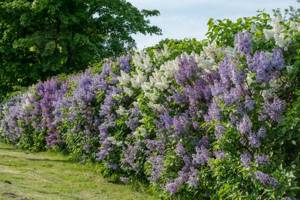
For a hedge, you can plant bushes of lilac flowers. This deciduous plant can grow up to 8 m. The leaves appear early and remain green for a long time. At the end of April, lilacs bloom. Flowers are purple, white, violet, lilac. There are varieties that bloom until summer, filling the air with a delightful aroma. Seedlings can be planted from mid-summer until autumn. It is imperative to loosen the soil, systematically water and remove weeds. This type of fencing is resistant to cold. With proper care, it can last for about 100 years.
Cupressociparis Leyland
You can make a high hedge with the help of the evergreen tree Kupressosiparis Leyland, which grows up to 20 m. It is distinguished by its rapid growth - in a year it can grow by 1.5 m. This tree has a dense crown. It has a symmetrical shape, and the shoots hang down. Cupressociparis can grow in shaded areas. Requires moderate humidity and soil rich in minerals. On normal days it has enough natural precipitation, but on dry days it needs to be watered periodically. Seedlings are planted in open ground after the final formation of the root system.
Hawthorn

For living fencing, you can plant certain varieties of hawthorn that can survive in different climates. They are frost resistant. These varieties have a dense crown and can be shaped. Hawthorn loves to grow in open areas. If it doesn't get enough sun, it won't bloom. The branches of the hawthorn are covered with thorns; after the bush has faded, reddish or orange fruits appear. It is recommended to plant the plant in the spring. Plants that have reached 4 years of age should be trimmed and shaped. Hawthorn is not a fast growing plant. It can take at least 10 years to get a beautiful flowering fence.
Willow
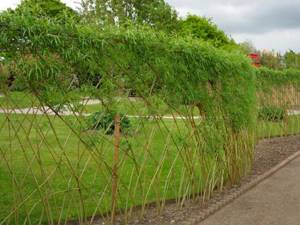
One of the simplest options for creating a hedge on a summer cottage is to plant willow. These trees are unpretentious, even thin twigs sprout roots. After their germination, it is necessary to observe how they form. If necessary, restrain their growth. Willow grows quite quickly, so creating a full-fledged fence will take little time, but it must be constantly cared for and monitored. For greater reliability, experts recommend using wire. It needs to be secured to vertical posts. The wire will not be visible because of the greenery, and the structure will be more solid.
Honeysuckle Honeysuckle
Varieties of honeysuckle - honeysuckle, grows like a vine, up to 6 m in height. Shoots are green and red. The plant blooms from late spring to early summer. Honeysuckle fruits are poisonous. It is dangerous to use them. Honeysuckle blooms well in a sunny area, although it can withstand frost. The plant is planted in spring, preferably in neutral acidic soil. Bushes do not like very dry and clay soil. To obtain a reliable fence, it is recommended to install supports. Honeysuckle care consists of:
- abundant and systematic watering;
- weed removal;
- pruning;
- creating a certain form.
Large-flowered Campsis
Campsis is a perennial tree-like vine with leaves that fall off in winter; it sometimes grows up to 15 m in length. As young branches grow, they twist around the supports in a helical manner, then they become like a tree, while the acquired shape is preserved. The liana blooms all summer with crimson or bright orange inflorescences. Flowers look like small gramophones. For best growth they need plenty of sun and warmth. Large-flowered campsis blooms profusely in neutral or slightly acidic soil. It is necessary to trim and guide the shoots because they grow very quickly. Old branches need to be removed so that new ones can grow in their place.
garden ivy
Beautiful green fences around the house and summer cottage can be created by planting garden ivy. This unpretentious plant does not matter where it grows in the sun or in the shade; it feels great everywhere. Ivy does not tolerate severe frosts well, so it is recommended to cover it in winter. He also doesn't like high humidity. The best place for ivy to grow is in elevated areas and away from strong winds.
At first, the plant will grow slowly, but as it gradually gets used to it, the growth process will accelerate. It is recommended to plant in early spring, then over the summer the ivy will have time to take root and take root. There is no need to water frequently; even in dry times, 1-2 times a week is enough. In autumn and during rains, watering is stopped. The soil needs to be loosened in order for the root system to be healthy.
Lawson's cypress
A coniferous plant such as Lawson's cypress is very often used when they want to create a living fence in a summer cottage. It will grow well in a place where there is always water, because it really needs it. In the summer, every day under one tree you need to pour a bucket of water and spray the crown. The site should be inaccessible to strong winds. At the very least, Lawson cypress should be fed with organic and mineral compounds once a month. In spring, the tree needs pruning; dry branches must be removed and growth controlled.
Lavrovishnya
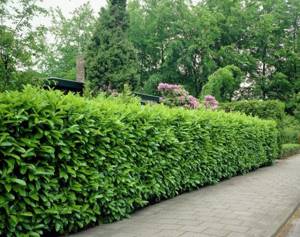
Medicinal cherry laurel is a shrub that grows quite quickly. The plant has long inflorescences consisting of very beautiful small flowers. The result is green, delightful decorative fencing structures. Cherry laurel is not afraid of severe frosts. It needs good watering. If you do not water the ground for a long time, the cherry laurel will stop blooming, bear fruit and begin to grow poorly. A living, fast-growing fence from this plant must be trimmed and shaped twice a year. The very first time the work is done the next year after the seedlings are planted, at the end of the summer period.
Balsam fir

Balsam fir can be planted in a shaded area. It is good if there is a body of water nearby, because the tree grows well in moist, well-drained soil, which contains a large amount of microelements.
Attention!
Water should not be allowed to stagnate.
Seedlings 4 years old should be planted in open ground. This should be done in April, choose a cloudy day for work. Dig holes for planting 14 days in advance. Although balsam fir tolerates frost well, sudden temperature changes can lead to frostbite in the trunk. Therefore, experts advise covering young plants with spruce branches during severe frosts. The roots of the fir are close to the surface of the earth; if the wind blows with great speed, it may well cause harm to the tree.
Thuja Smaragd
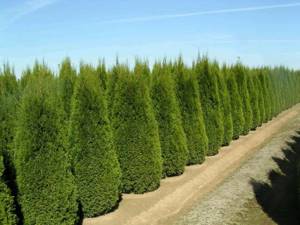
A hedge at the dacha made from thuja Smaragd is a good option. It grows up to 5 m, with a girth of 2 m, so when planting seedlings it is necessary to take into account the large size of the future tree. Even with a sufficient distance between them, the fence will be dense and reliable. Thuja grows at a slow pace. Every year it grows no more than 10 cm in height and 5 cm in width. Life expectancy is 150 years. Grows well in sun and shade.
Rules and nuances of caring for a living fence
During the entire period of existence of the green fencing structure, from planting to removal, it is necessary to care for the plants: watering, mowing, hilling, removing weeds, applying fertilizers. It is extremely difficult to put a neglected hedge in order; sometimes all you can do is cut it very short, literally growing it all over again.
Deciduous trees and shrubs that make up the living fence are seriously pruned after planting in the hole. The above-ground part will be 10-15 centimeters, which allows you to increase the growth rate of shoots. If the roots are exposed, prune to half the existing height. When the plants were placed in a special container, pruning was done only to a third of the length.
After one year, the green hedge is trimmed about 4 times in one season. This pruning is used to form bushes, trees, plants, and increase branching density.
You will need to trim heavily:
- privet;
- hawthorn;
- thorn;
- Tamarix.
It is enough to cut it to a third of the length:
- cotoneaster;
- hornbeam;
- beech;
- barberry;
- boxwood
After another 24-36 months, only decorative leveling of the fence is done, by trimming branches and trimming the upper shoots.
Deciduous hedges and bushes are trimmed early in the spring, before the foliage is renewed, and coniferous hedges - in late spring or early autumn.
You need to know that the deciduous version is cut more from the top: the upper part is created narrower so that the lower part receives a sufficient level of lighting.
It is also important to do regular watering and loosening the soil. When watering, you need to saturate the soil by about 50 centimeters.
It is necessary to saturate the soil with organic matter and minerals in a timely manner. Organic fertilizers include:
- compost;
- leaf humus;
- peat.
Apply fertilizing in early spring or autumn, 2-5 kilograms per 1 square meter of territory.
Mineral fertilizers are nitrogen and phosphate-potassium supplements. They are introduced into the soil in late summer or early autumn.
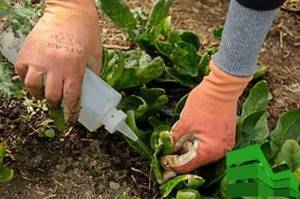
The most dense fencing is created from hawthorn and yellow acacia. The branches are strongly intertwined, maintaining dense protection all year round.
The most secure hedge grows from thorn bushes. Dense, strong, thorny bushes will not allow an uninvited guest into the property.
The tallest protective structures are made from yew, thuja, spruce, and juniper.
If a person wants a more thorny fence, it is recommended to plant Eleven angustifolia, barberry, and scarlet pyracantha.
When low-rise structures are made, it is possible to create an unusual look using boxwood. The plant is easy to trim and allows you to create even the most complex shapes.
When cutting a fence, you can create any shape, but it is recommended to make it rectangular. This option is most suitable for the border. The round type of hedge will be more difficult to implement, but it is also universal, suitable for almost all plants.
Mechanical processing of vegetation should be done in the evening to minimize the risk of sunburn from bare branches. Immediately after pruning, you need to water it abundantly and cover the soil with straw.
If the bushes are still young, then 25 centimeters of the total annual growth are cut off, even if only 5 centimeters remain - that’s okay. When the bush is already quite mature, reaching the age of 4 years or more, it is enough to cut 10 centimeters.
It is not always possible to protect vegetation from diseases, damage, and wilting. It is possible to refresh the plantings by pruning at a height of 10-15 centimeters from the soil surface, and the pruning areas are treated with “chatter”. On stumps, new shoots will grow faster than even on young seedlings, due to the highly developed root system.
Undesirable plants for perennial hedges
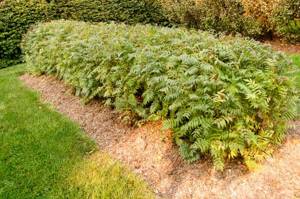
Plants that are difficult to form should not be planted as a green hedge. Experts do not advise planting birch trees in a small garden, because the roots of the tree suck out moisture, harming the plants growing nearby. Varietal lilac should not be used, since over time its lower part becomes bare, which means it will have to be masked with other plantings. A delightful fence is obtained from viburnum planted around the perimeter of the area. But we must keep in mind that it is often attacked by pests, which can eat it during the spring.
You should not build a fence using plants that are characterized by strong creeping and, as a result, a lot of root branches: decorative flowering mapinuclene, rowan-leaved fieldfare, silvery gooseberry. The Sakhalin knotweed creates an excellent living fence, but it throws out a lot of shoots.
Green hedge care

It is important to remember that hedges need to be well watered during dry periods over the next two years. They also need to be fertilized annually (all-purpose fertilizer at a rate of 70 g per square meter is suitable), and, if necessary, re-mulched.
There should be no weeds at a distance of 45 cm on each side of the hedge.
Key nuances when landing
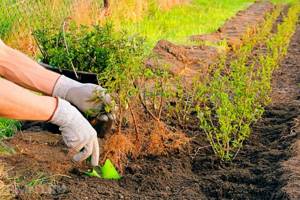
Instead of digging a separate hole for each plant, experts recommend digging a trench that will have the same planting depth. It is necessary to monitor the burial line. The seedlings are deepened in the same way as they grew before planting in open ground. At the bottom you need to pour a little ready-made compost or horn shavings. The distance at which they are planted in relation to each other depends on the type of plant and its size. If a lump of earth on a purchased seedling is wrapped in a mesh made of decomposing material, then it is simply cut; if it is made of synthetics, it is removed. After the plant is planted, you need to make the branches shorter and water the soil generously.
Trimming and trimming hedges
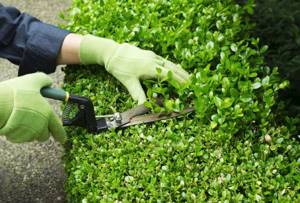
It’s not enough to just make a green hedge in your dacha and leave it to chance. It needs to be looked after - the plantings must be trimmed, leaving a height of 2-3 m. For this work, purchase pruners with large blades and long handles. Only with them can you cut off thick branches. Every year, dried, old and thick shoots are cut off. During the season, work on the formation of bushes is carried out at least 2 times, 10 cm of growth is removed at a time.
Technology for planting shrubs and trees for hedges
According to planting rules, the density of a hedge depends on the specific plants being planted, the expected height of their growth and the number of rows of hedges.
To plant a hedge the way the correct technology suggests, you need to start with markings, marking two points with pegs - the beginning and end of the fence. When driving pegs into the soil, they retreat from the border of the site or fence by about 50 cm.
A cord is attached to the pegs and pulled tightly to mark the planting line, along which a trench is dug from 40 to 90 cm wide or more, depending on the row of plantings.
For a single-row hedge, the trench width is 40-50 cm; for multi-row plantings, add 50 cm for each subsequent row. If you plan to create a hedge of 2-3 rows of spreading plants, then it is better to dig the appropriate number of trenches for planting them.
In accordance with the technology of planting a hedge, a trench is dug to a depth of about 50 cm (more precisely, the depth is set based on the needs of the root system of a particular planting material).
For a well-developed root system, you can make the trench wider and deeper. For a plant whose root system is shallow, a trench with a shallower depth is sufficient, but no less than the bayonet of a shovel.
As shown in the photo, the bottom of the trench for a hedge planted with your own hands is carefully loosened, fully mature compost, peat or rotted manure is poured:
In some cases, depending on the needs of the plants, it is possible to mix organic matter with the top fertile layer of soil. It is better to select your own soil composition for each type of plant.
Also, based on the needs of the plants being planted, mineral fertilizers are applied, the approximate volume of complex fertilizer is 50-60 g per 1 linear meter. m. Then they water the soil in the trench, place the seedlings in the prepared place and compact the soil.
Before planting, damaged parts of the roots are removed from seedlings with an open root system using pruning shears. For plants whose roots are packed in a sheath, the root system is released directly in the planting hole.
The roots of the seedling are carefully straightened and sprinkled with soil mixture, compacting it so that there are no voids left around the roots.
To make the hedge as strong as possible, the soil around the seedlings is trampled down, a roller is placed around the stem of each plant to form a hole for watering, and then watered so that the soil lump is completely saturated with moisture
Immediately after planting, the damaged parts of the branches are removed with pruning shears. Deciduous plants are cut back to a third of their height. This completes the planting.
When planting seedlings, strictly measure the distance between plantings in a row.
The distance between seedlings in a row is individual; it depends directly on the type of plant, the growth rate of trees or shrubs and their approximate width in adulthood. For example, rosehip seedlings can be planted at a distance of 50-80 cm from one another.
The recommended scheme for planting hedge seedlings per 1 linear meter is as follows:
- Low shrubs - 5-7 bushes
- Medium shrubs - 4-5 bushes
- Tall (2-3 m) bushes and trees - 1-2 plants
